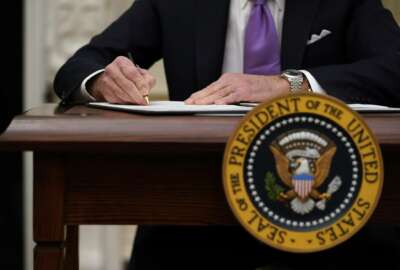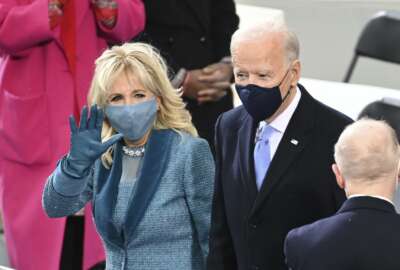
28 EOs in 2 weeks? Career executives are used to the transition policy sprint
Most career executives are accustomed to the steady stream of new directives and memos at the start of new administrations, but it puts pressure on them to ensu...
In most cases, career federal employees are ready — or at least accustomed to — the steady stream of executive orders, memos and policy directives that come at the beginning of most new administrations.
But the deluge does often put more pressure on career executives who have to ensure their employees in the field aren’t experiencing an acute case of policy whiplash.
During his first two weeks in office, President Joe Biden has out-signed his last four predecessors, at least, signing 28 different executive orders since Jan. 20.
The orders task agencies with a seemingly never-ending list of new activities, from rescinding previous policies and creating new ones, to standing up new task forces or preparing recommendations.
On his first day in office, Biden also identified more than 100 pieces of guidance, regulations and other actions for agencies to review and reconsider in accordance with new climate actions.
The preparation for these new policies starts often during the presidential transition, said Don Bice, a former deputy assistant secretary for administration at the Agriculture Department and a current director at BDO Public Sector.
Bice worked with landing teams and served as an acting USDA official during previous presidential transitions. He said the transition teams begin communicating priorities from the incoming president with career employees well before Inauguration Day.
Transition officials often set goals for the first 30, 60 and 90 days of the new administration, and it’s up to career employees to implement them.
“During the transition, the transition teams are looking at the regulatory actions that the department has or that are ongoing or recently finalized,” Bice said. “They’re looking at internal guidance and other documents. Oftentimes you may see an executive order that says, do X, Y and Z. But every agency needs to do an inventory of their programs and guidance documents and regulations that are related to that executive order. There’s a whole host of things that happen that go beyond just meeting the deadline.”
Seasoned career employees know and understand the priorities an incoming administration has and how they differ from the previous or current team, Bice said. If they’re not aware, they’ll quickly get up to speed during the transition.
“We had a pretty good idea of what was going to come out,” said David Grant, a partner at Potomac Ridge Consulting and a longtime executive at FEMA and the IRS. “We were pretty much ready for it. The more communication you have up front, the easier it is to implement.”
In some cases, Biden’s executive actions rescinded policies from the prior administration and directed agencies to stop the activities they had been doing and take completely new actions.
A Jan. 20 executive order, for example, paused wall construction along the southern border and directed the Department of Homeland Security and other agencies to revisit existing contracts and find ways to repurpose them.
Other memos placed temporary moratoriums on oil and natural gas leases, stopped the United States’ withdrawal from the World Health Organization, repealed prior travel bans and ordered a governmentwide pause in most regulatory activity.
“Anyone who’s spent time in D.C. will say you learn not to take things personally,” said Greg Giddens, a partner at Potomac Ridge Consulting and a former executive who spent several years at the departments of Veterans Affairs and Homeland Security. “We’re in a role where we advise and make sure there’s a well-informed policy, and then we implement the policy.”
Bice recalled a time at USDA when he spent a year working to implement a new regulation. The interim rule was set to go into effect near the end of an administration.
“I had worked really quite hard to get it in place and got some recognition from the administration at the time,” he said. “We went through a transition and the very first question that a new policy official in that particular area asked me was, ‘How do I get rid of that rule?’ I spent a year getting rid of the rule that I spent a year putting in place. But that is something that most career employees are used to.”
Former executives like Giddens and Bice all described a process of “running through the tape,” where agencies would hurry to implement the policies and program directives of the current administration before a new team takes its place.
The Trump administration — and others before it —rolled out a series of last-minute regulations, memos and policy directives in the final days of the presidency.
During the presidential transitions Bice, Giddens and Grant worked on, agencies often paused current activities to give the incoming administration the time and space to roll out their own activities.
“Career officials are used to that change, running through the tape and also at the beginning of the administration pausing what they’re working on to make sure that they give the incoming administration all of the ability to see what is being produced so they’re comfortable with what gets produced,” Bice said.
The current situation may be different, they all acknowledged, since some agencies didn’t begin traditional transition activities until mid-to-late November.
It’s ultimately up to career executives to balance the work of the current administration with the planning and preparation that the incoming team expects to accomplish during the transition.
“Most administrations want to finish strong, but the next group is going to want to sprint out of the gate,” said Giddens. It’s also important for career leaders to ensure their employees aren’t feeling run down by the process, he added.
The process of readjusting to new priorities and policy goals isn’t unique to presidential transitions either, Grant added. Career employees are relatively accustomed to those changes, in part, because few political appointees stay at their agencies for a full four-year term.
Giddens recalled working at the VA when former Secretary Bob McDonald came in to lead the department halfway through the second term of the Obama administration. The new secretary, he said, brought a lot of change very quickly into the department.
New policy directives have ‘ripple effect’ across an agency
Though career employees may be accustomed to deluge of new executive orders and policy directives at the start of a new administration, there are other factors that might complicate their efforts to quickly implement them.
The volume of new directives coming from the Biden administration during its first two weeks in office is higher than the last four administrations combined.
And some agencies have fewer career employees on board today than they did four-to-five years ago. The size of the USDA workforce, for example, dropped by more than 4,800 employees between September 2016 and September 2020, according to the most recent data from the Office of Personnel Management.
“This may be a particularly difficult time. In terms of federal staffing we’re lower than we’ve been in many years in most of the departments,” Bice said. “It will require even more to be done than previously because I think we have fewer people who are in those roles. The smart managers in government, the career people, understand that they have a limited capacity to do everything.”
Career executives and others who interact closely with current and incoming political appointees feel the transition policy sprint the most intensely — at least at first.
“For the most part government works pretty slowly,” Bice said. “Those changes happen over time. It’s not necessarily a light switch that goes on and off.”
New policy directives usually reach the executive level first before slowly rippling throughout the rest of the organization to employees in the field.
“It wouldn’t be healthy for an organization; you can’t have your people feeling whip-sawed by new policy in the field,” said Grant, who spent the first 11 months of the Trump administration as FEMA’s acting deputy administrator.
But it’s up to senior career executives to bridge the gap between the political appointees and their new policy directives and the staff in the field who may eventually implement those changes at the programmatic level.
“They translate those new executive orders or policies into the language of the organization,” Grant said. “It filters out, and there’s a well worn process to get that done.”
It’s also up to the career executives to steer their employees through sudden policy changes — and explain to the new political appointees what it’ll take to implement a new directive and the consequences of eliminating the old ones.
Grant said the the most successful appointees take time to learn about the organization they’re entering, or, as may be the case for some Biden appointees, to learn about what’s changed at the agency they’re rejoining. It goes both ways for the career staff.
“All these folks need to learn as much about the agency as the agency needs to learn about them,” he said.
Copyright © 2024 Federal News Network. All rights reserved. This website is not intended for users located within the European Economic Area.
Nicole Ogrysko is a reporter for Federal News Network focusing on the federal workforce and federal pay and benefits.
Follow @nogryskoWFED
Related Stories





